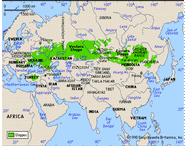
Professor of English Naomi Guttman and Associate Professor of Russian Studies Franklin Sciacca were presenters at the Oxford Symposium on Food and Cookery at St. Catherine’s College, Oxford, U.K. July 6-8. Their paper, titled “The Magic of Dumplings: Bringing Pierogi into the (New) World,” offered an early example of globalization, the migration of a foodstuff from the Ukraine along the Silk Route across the Eurasian plain and ultimately to the United States.
The 31-year-old gathering of food historians, writers, anthropologists and scientists meets each year to exchange ideas radiating from a central topic. This year's topic focused on "wrapped and stuffed" foods.
According to Guttman and Sciacca, “The half-moon-shaped stuffed boiled dumpling of Ukraine-Poland [is] called by a variety of names: varenyky and pyrohy in Ukrainian, pierogi in Polish, kolduny in Belarusian.” In their paper, the authors addressed the ritual significance of the food in life cycles and agrarian celebrations. “Slavic stuffed dumplings function as a cultural mnemonic of the peasant cuisine of preindustrial Poland and Ukraine. Just as dumplings embody nostalgia for the past in contemporary Eastern European cities, in North America they also function to reify ethnic identity among Slavic immigrants and their descendants. In North America, Polish and Ukrainian communities coalesced around national churches, so it makes sense that church became the locus around which cultural traditions (language, cuisine, ritual) were preserved. Meanwhile, in the post-Soviet homelands, dumplings have likewise become a conscious evocation of nostalgia for an idealized village life that has disappeared and continue to play a dynamic role in preserving national roots and ethnic identity in an ever-globalizing world.”
Sciacca is working with the College’s Digital Humanity Initiative to establish a template to track the migration of the food and to demonstrate parallels to the migration of people, the spread of language and the trading of ideas as well as goods. The authors suggested, “It could be said that pierogi/varenyky is Slavic soul-food, a comforting reminder of family traditions and ethnic identity that delivers to both diasporic and post-Soviet Slavs a dose of nostalgia for lost village and folk culture, binding individuals to each other and to the past.”
